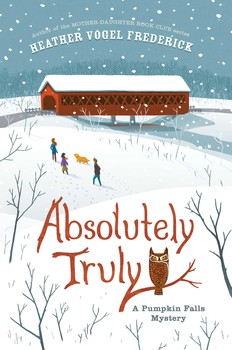
At almost six feet tall, twelve-year-old Truly Lovejoy stands out in a crowd whether she likes it or not. (She doesn’t.) So when her family moves to teeny-tiny, super boring Pumpkin Falls, New Hampshire, Truly doesn’t stand a chance of blending in. But when helping out at the family bookstore one day, Truly finds a mysterious letter inside an old copy of
Charlotte’s Web and soon she and her new friends are swept up in a madcap treasure hunt around town. While chasing clues that could spell danger, Truly discovers there’s more to Pumpkin Falls than meets the eye—and that blending in can be overrated.
Hea ther Vogel Frederick is no stranger to middle grade fiction. She is the author of the Patience Goodspeed historical novels, the Spy Mice series and the Mother-Daughter Bookclub series. Her newest venture is the Pumpkin Falls mysteries which launched this fall Absolutely Truly, which has just been nominated for an Edgar Award. Heather is also my friend and neighbor in Portland. We have a regular working coffee date so I thought I’d ask her about making the shift to mystery stories.
ther Vogel Frederick is no stranger to middle grade fiction. She is the author of the Patience Goodspeed historical novels, the Spy Mice series and the Mother-Daughter Bookclub series. Her newest venture is the Pumpkin Falls mysteries which launched this fall Absolutely Truly, which has just been nominated for an Edgar Award. Heather is also my friend and neighbor in Portland. We have a regular working coffee date so I thought I’d ask her about making the shift to mystery stories.
Heather, you’ve published 17 books and yet this is your first mystery. What made you want to give this genre a try?
I didn’t plan to—I have to admit I’m an accidental mystery novelist.
I was tinkering with a contemporary story about a big family who moves to a small town in New England, like one of the ones in which I grew up—Peterborough and Hanover, New Hampshire, and Lexington and Concord, Massachusetts. I love small towns, and I heartily agree with Jane Austen’s writing advice: “Three or four families in a country village is the very thing to work on….” I had fun dreaming up Pumpkin Falls, New Hampshire, and quickly settled on a main character—12-year-old Truly Lovejoy—but beyond that, details were vague. I certainly didn’t have anything resembling a plot.
Then the Boston bombing happened in April 2013.
I was moved by accounts of the many veterans who went to visit and encourage those who lost limbs that sad day. Years ago, my maternal grandfather worked for the Canadian Railroad, and he lost a leg in a rail yard accident. Unable to work and saddled with a heavy, painful wooden leg, his life spiraled downward. Listening to news reports from Boston that spring, I found myself thinking a lot about him, and how his story might have had a happier ending if comfortable, high-tech modern-day prostheses had been available, and if he’d had someone to champion and encourage him.
Coincidentally, I’d also been thinking a lot about my other grandfather, who opened a bookshop in Providence, Rhode Island back in the early 1930s. I have this fabulous picture of him sitting in his store—the Ultima Bookshop—and it’s easy for me to imagine him brimming with hopes and dreams. Unfortunately, with the Depression bearing down, the bookshop faltered and eventually closed its doors after just a few short years.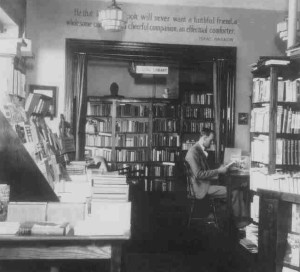
Somehow, these unrelated personal family connections and musings converged as I was muddling my way through the first draft of ABSOLUTELY TRULY. A struggling family bookshop suddenly popped up. A parent who suffers the loss of a limb strode onstage. And then, as the story ripened, one day out of the blue Truly discovered a decades-old undelivered letter inside an autographed first edition of CHARLOTTE’S WEB. When the first edition disappeared from the bookstore, I realized that I had a full-blown mystery on my hands.
Did you have a favorite mystery series when you were growing up? A favorite mystery writer now?
My family lived for a time in England when I was in middle school, and I’ve been a sucker for British mysteries ever since. I cut my teeth on Agatha Christie (I give her a shout out in ABSOLUTELY TRULY via a bookstore dog named Miss Marple), then later moved on to Dorothy Sayers, Josephine Tey, P.D. James, and so on. Right now, I’m completely enamored of Jacqueline Winspear’s MAISIE DOBBS series. It’s set in England in the years between the two World Wars, and combines many elements that I love in a mystery, including a vivid sense of place and finely-drawn characters.
Do you find you plot a mystery novel differently than other stories?
Hugely different! I am a total “pantster”—a writer who flies by the seat of his or her pants—as opposed to a “plotter”—one who meticulously constructs a plot before picking up a pen—so I had to turn my usual writing process on its ear. At the heart of mystery writing is crafting a satisfying puzzle, of course, with clues and red herrings and false leads and all that. While there were still times when my natural instinct took over and I experienced that exhilarating rush of surprise I find so bracing as a writer, there was a great deal more plotting this time around.
What are three things you wished you knew before starting a mystery series?
- How to write a mystery.
- How to write a mystery.
- How to write a mystery.
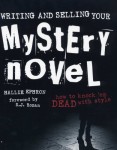 Seriously, writing is hard, but writing a mystery is harder. My husband can attest to this; he had to listen to me whine even more than usual during the long months I wrestled with this story! I found a few books on the craft helpful, including WRITING AND SELLING YOUR MYSTERY NOVEL by Hallie Ephron, but mostly I just trusted my gut and bumbled my way through….
Seriously, writing is hard, but writing a mystery is harder. My husband can attest to this; he had to listen to me whine even more than usual during the long months I wrestled with this story! I found a few books on the craft helpful, including WRITING AND SELLING YOUR MYSTERY NOVEL by Hallie Ephron, but mostly I just trusted my gut and bumbled my way through….
I understand you had an interesting research experience while writing the book.
I absolutely truly did! I began my writing career as a journalist, and a few years ago I ran into Victoria Irwin, a former colleague from The Christian Science Monitor, at a PNBA (Pacific Northwest Booksellers’ Association) event. It was fun to reconnect and discover that we’d both ended up making a life in books—she’s the events coordinator at Eagle Harbor Book Co. on Bainbridge Island, Washington.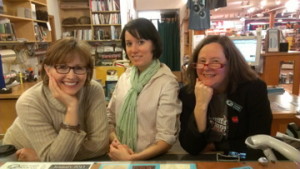
At the point at which I knew that Lovejoy’s Books would be central to my story’s setting, I realized I needed more information. Even though I’ve spent plenty of time in bookshops as a customer, now I needed to know what happens on the other side of the counter. So I called Victoria and asked if I might be able to hang out with her at Eagle Harbor Book Co. She and bookshop owner Rene Kirkpatrick were fabulous, and welcomed me with open arms. I took the ferry over from Seattle and stayed with Victoria and her family for a long weekend, and spent my days shadowing her and the rest of the bookstore staff. I had a blast! So much so, in fact, that I sometimes wonder if I’ve missed my calling. I guess I’m my grandfather’s granddaughter after all.
Will there be another Pumpkin Falls mystery?
Yes! I can’t wait to return to Pumpkin Falls. I’m just now dipping my toes into the first draft of YOURS TRULY, in which our intrepid heroine discovers a diary belonging to the ancestor for whom she was named, learns that her home was a stop on the Underground Railroad, and unravels a Civil War-era mystery. Strange things are happening at a nearby maple syrup farm, too, so once again Truly and her friends will have their hands full investigating. I expect the book will be published sometime in 2016.
Oh, and here’s a fun fact to leave you with: I ended up dedicating ABSOLUTELY TRULY to both of my grandfathers, and now you know why.
Thanks for stopping by the Mixed-Up Files! We’ll be looking for Yours Truly next year.
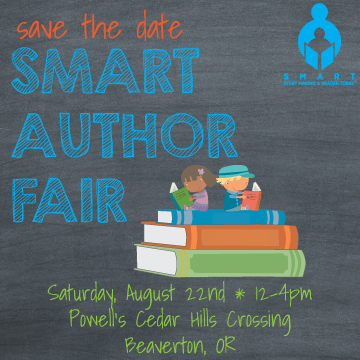 I am so honored to be invited to participate in this years SMART author fair at Powells bookstore.
I am so honored to be invited to participate in this years SMART author fair at Powells bookstore.
![TurnTide jacket[1]](https://rosanneparry.com/wp-content/uploads/2015/06/TurnTide-jacket1.jpg)
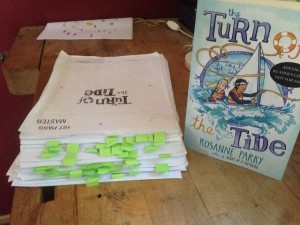 .
.




 ther Vogel Frederick is no stranger to middle grade fiction. She is the author of the Patience Goodspeed historical novels, the Spy Mice series and the Mother-Daughter Bookclub series. Her newest venture is the Pumpkin Falls mysteries which launched this fall Absolutely Truly, which has just been nominated for an
ther Vogel Frederick is no stranger to middle grade fiction. She is the author of the Patience Goodspeed historical novels, the Spy Mice series and the Mother-Daughter Bookclub series. Her newest venture is the Pumpkin Falls mysteries which launched this fall Absolutely Truly, which has just been nominated for an 

